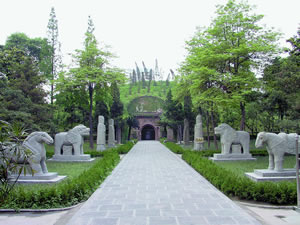 Among the places of historical interests in Chengdu, the capital of Southwest China's Sichuan Province, the Du Fu Thatched Cottage and the Temple of Marquis Wu are the most acclaimed.
Among the places of historical interests in Chengdu, the capital of Southwest China's Sichuan Province, the Du Fu Thatched Cottage and the Temple of Marquis Wu are the most acclaimed.
However, in the western part of Chengdu there is a less well-known but equally interesting site: the Yongling Mausoleum Museum where Wang Jian (847-918) was buried.
A native of Henan Province, Wang lived most of his life at the end of the Tang Dynasty (618-907) when imperial rule was weak and ambitious warlords were locked in incessant combat, competing for control of the country.
Formerly a hooligan, Wang, who joined the army at a young age, became a favorite of the emperor and finally rose to become a powerful warlord.
After the Tang Dynasty collapsed, China was divided into many states. There were five dynasties in the north and 10 kingdoms in the south. Hence the name of the period - Five Dynasties and Ten Kingdoms (907-974).
In the year 907, Wang established his own kingdom in the south - the Shu Kingdom (907-925). During his 11-year reign, he made his kingdom one of the most powerful and richest in the south.
After Wang died, he was buried in Chengdu, becoming one of only a few kings ever to be buried in Sichuan.
Kings usually liked having their tombs built deep in the earth, but Wang was an exception.
"In ancient times, Chengdu abounded in underground water. If a tomb was buried deep, the coffin could rot easily. So Wang Jian chose to build his tomb above ground," archaeologist Liu Fuzhang explained.
Liu, 89, was one of several archaeologists who worked on the site when Wang's mausoleum was first excavated in 1942. He worked in the Yongling Mausoleum until he retired in 1976. He knows more about the mausoleum than anyone living, according to Ma Wenbin, a leading museum official.
Ma said that since his retirement, Liu was always called upon to serve as a guide whenever VIPs came to visit the museum.
Huge Mound
Just inside the museum's front gate, a tree-shaded path lined with stone statues of civil servants and generals leads to the mausoleum.
With a height of 15 meters and a diameter of about 90 meters, the outside of the mausoleum looks like a huge mound.
Inside, there is the stone coffin chamber measuring 30.8 meters across, 6 meters wide and 20 meters tall. The chamber contains three objects: a huge stone platform, a stone vessel and a stone seated statue of Wang Jian.
The platform is in the center of the chamber. It was on the platform that Wang's coffin was placed. When the mausoleum was excavated, the coffin was found to have rotted away. No bones were discovered, only pieces of wood on the platform. At the end of the chamber is an 86-centimetre-tall seated statue of Wang.
In front of the statue and behind the platform is a huge vessel that contained oil to light a so-called "Everlasting Lamp".
"In fact, the light could not have lasted forever," Liu pointed out. "But thanks to the lighting of the lamp, the oxygen inside the mausoleum was consumed. This kept objects inside the mausoleum from decaying more quickly."
When building the mausoleum, workers first used large stones to make the arch-shaped coffin chamber above ground, then they covered the chamber with tons of mud.
When Liang Sicheng, a renowned Chinese architect, visited the stone chamber in the 1950s, he said that it was really a marvel as it had no supporting pillars.
In the 1,085 years since Wang was buried, many earthquakes have taken place in Chengdu. But the chamber has continued to support the heavy mud.
Rare Relics
Wang's mausoleum was sacked soon after his kingdom was toppled. Even so, about 400 relics, including silverware, jade ware, copperware, ironware and earthenware, were found during excavation work. The most valuable pieces were a jade seal for the "nether world" and a jade girdle.
The seal, 11.7 centimeters by 10.7 centimeters by 3.4 centimeters, is one of only two seals for the "nether world" to have been discovered in the tomb of a king or emperor. The other was found in the tomb of Emperor Wanli of the Ming Dynasty (1364-1644), Ma said.
Relics from the Five Dynasties and Ten Kingdoms period - a relatively short time - have seldom been uncovered. This makes the treasure finds in the hall very important for the study of the period.
Relief Sculptures
On the south and north sides of the stone platform are relief sculptures of two women dancers and 22 musicians, who were members of Wang's imperial band.
All 22 musicians are seated and playing different instruments, including the clapper, flute, konghou (an ancient plucked, stringed instrument), zither, sheng (a reed-pipe wind instrument), waist drums, conch and orange leaf (blowing a rolled orange or reed leaf to produce beautiful musical notes was popular in the Tang Dynasty).
Looking plump, the dancers and musicians are in Tang Dynasty costumes.
A music aficionado, Wang's palace entertainment imitated the imperial bands of the courts of the Tang Dynasty and he established his own band at his court.
Archaeologists believe that the relief sculptures are the most completely preserved sculptures of the imperial bands of the Tang Dynasty.
They proved invaluable in studying the art, the sculpture and the music of the court, the organization of the imperial band and women's dress during the Tang Dynasty.
(Shanghai Star April 25, 2003)
|

